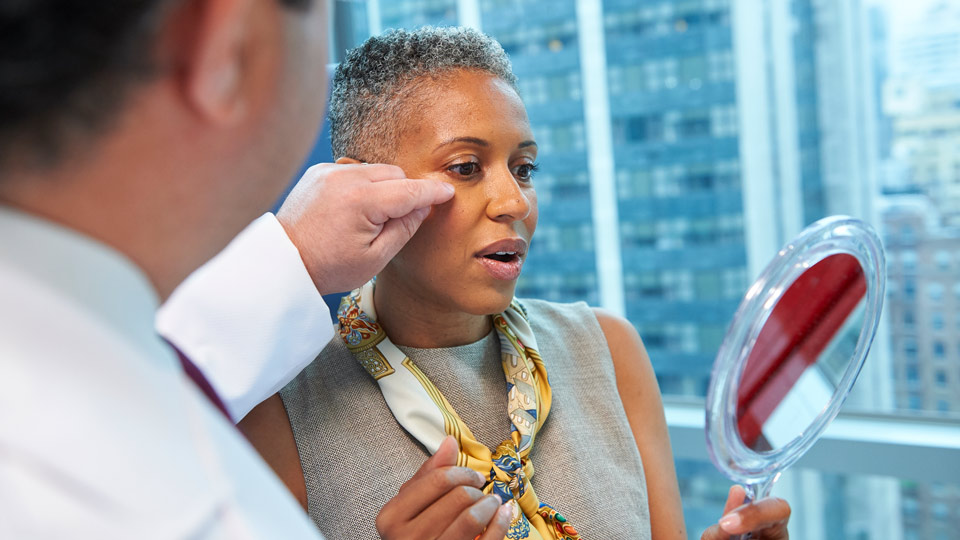The Function of a Dermatologist in Diagnosing and Treating Different Skin Disorders
The function of a dermatologist extends far past basic skin care; it incorporates the detailed processes of detecting and treating a wide array of skin disorders. Through their specialized training, dermatologists utilize advanced analysis methods to identify problems such as psoriasis, acne, and eczema, customizing treatment plans to meet specific client needs. The complexity of skin disorders frequently needs a complex method that includes not only medical treatments yet also client education and preventative approaches. What implications does this thorough care have for patient outcomes and overall skin health?

Value of Skin-related Know-how
The experience of dermatologists is crucial in the diagnosis and administration of skin disorders, as they possess specialized understanding that extends beyond basic medical training. This innovative understanding is necessary for properly recognizing a vast array of skin problem, which commonly offer with overlapping signs that can perplex non-specialist practitioners. Dermatologists are educated to separate between various skin conditions, making certain appropriate treatment strategies are applied promptly.
In addition, the area of dermatology includes an one-of-a-kind mix of professional abilities and sophisticated technology. Skin specialists make use of sophisticated analysis tools, such as dermatoscopes and skin biopsies, to evaluate skin sores and identify their nature. This technical proficiency enables early detection of possibly significant conditions, consisting of skin cancers cells, which can significantly improve client outcomes.

Common Skin Disorders Diagnosed
Various skin conditions can provide with varying levels of seriousness and intricacy, making skin-related competence crucial for precise medical diagnosis and administration. Amongst the most widespread problems are acne vulgaris, eczema, dermatitis, and psoriasis.
Acne vulgaris, defined by the existence of papules, comedones, and pustules, largely affects adolescents but can continue right into the adult years. Dermatitis, or atopic dermatitis, is a persistent inflammatory problem that results in dry, itchy, and swollen skin. Psoriasis is an autoimmune problem that materializes as red, scaly plaques, largely on extensor surface areas, and can significantly impact the top quality of life.
Various other common conditions include rosacea, which presents with face flushing and visible capillary, and seborrheic dermatitis, usually causing dandruff and oily patches on the scalp. Fungal infections, such as tinea pedis (athlete's foot) and tinea corporis (ringworm), are likewise regularly run into.
These varied problems require a detailed understanding of pathophysiology, as well as knowledge of therapeutic alternatives, to guide effective therapy strategies - Dermatologist Raleigh NC. Via accurate medical diagnosis, skin specialists can offer tailored monitoring plans that resolve both the symptoms and underlying reasons for these typical skin disorders
Diagnostic Methods Utilized
Exactly how do skin doctors accurately identify numerous skin disorders? Skin doctors employ a mix of scientific examinations, diagnostic devices, and specialized methods to ensure accurate identification of skin disease. The first action commonly entails a thorough case history and checkup. Throughout this process, skin specialists evaluate the patient's signs, onset, period, and any potential triggers.
Among the primary analysis strategies is dermoscopy, which utilizes a handheld tool to multiply skin sores, enabling in-depth exam of frameworks not visible to the naked eye. Furthermore, skin biopsies are often done, where a tiny sample of skin is gotten rid of for histopathological analysis. This strategy is very useful for detecting problems such as cancer malignancy and other skin cancers.
Patch testing is one more crucial technique utilized to identify contact dermatitis by revealing tiny quantities of prospective irritants to the skin. Lab examinations, consisting of blood tests and societies, may be conducted to rule out systemic problems or infections. Collectively, these analysis strategies permit dermatologists to develop a detailed understanding of skin conditions, bring about exact diagnoses and educated person management.

Treatment Options Offered
A wide array of therapy alternatives is available for managing skin disorders, customized to the certain problem and private patient needs. Skin doctors use both topical and systemic treatments, depending on the severity and kind of skin problem. Topical therapies, such as corticosteroids, retinoids, and calcineurin inhibitors, are typically prescribed for problems like eczema, psoriasis, and acne. These representatives target swelling and advertise skin healing.
For more severe conditions, systemic therapies might be necessary. These include oral medicines such as anti-biotics for microbial infections and you can check here immunosuppressants for autoimmune conditions. Biologics, a more recent class of medications, have shown effectiveness in treating persistent inflammatory conditions like psoriasis and atopic dermatitis.
In enhancement to pharmacologic interventions, skin specialists may advise procedural alternatives such as laser therapy, chemical, or phototherapy peels (Dermatologist Raleigh NC). These treatments can attend to coloring problems, acne scarring, and various other skin abnormalities effectively
Moreover, way of life adjustments, consisting of correct skin care regimens and sun protection, play an essential function in the general management of skin disorders. By combining these treatment methods, skin specialists intend to enhance person end results and boost top quality of life for those affected by skin problems.
Patient Education and Support
Empowerment through understanding is necessary in the administration of skin problems, as patient education and learning and assistance substantially affect therapy outcomes. Skin specialists play an essential role in supplying individuals with thorough information about their conditions, therapy options, and self-care techniques. Effective communication cultivates a collaborative setting where individuals can proactively join their own treatment.

Support expands past education; it incorporates psychological reassurance and ongoing encouragement. Skin doctors ought to create a secure room for individuals to express their issues and ask concerns. Resources such as informative handouts, websites, and support system can even more encourage clients, allowing them to get in touch with others dealing with comparable obstacles.
Ultimately, a well-informed patient is most likely to take part in their treatment journey, causing much better adherence, contentment, and enhanced health results. The dermatologist's function in client education and learning and support is basic to optimizing the administration of skin disorders.
Final Thought
In verdict, dermatologists play a crucial duty in the reliable diagnosis and treatment of a wide variety of skin disorders. Their customized competence, combined with advanced analysis strategies and tailored treatment strategies, guarantees thorough care for people. Additionally, the focus on patient education fosters positive administration of skin health and wellness, empowering people to take informed activities regarding their skin care regimens. The payments of skin specialists considerably enhance the top quality of life for those affected by skin conditions.
The function of a skin doctor expands much past basic skin care; it encompasses the detailed processes of diagnosing and dealing with a large selection of skin disorders. Skin doctors utilize advanced analysis tools, such as dermatoscopes and skin biopsies, to evaluate skin lesions and establish their my response nature. Inevitably, the specialized training and experience of dermatologists are indispensable in supplying extensive care for clients with skin problems.
Additionally, skin biopsies are frequently carried out, wherein a tiny example of skin is eliminated for histopathological analysis. Jointly, these analysis techniques permit dermatologists to create a comprehensive understanding of skin conditions, leading to exact diagnoses and educated individual administration.